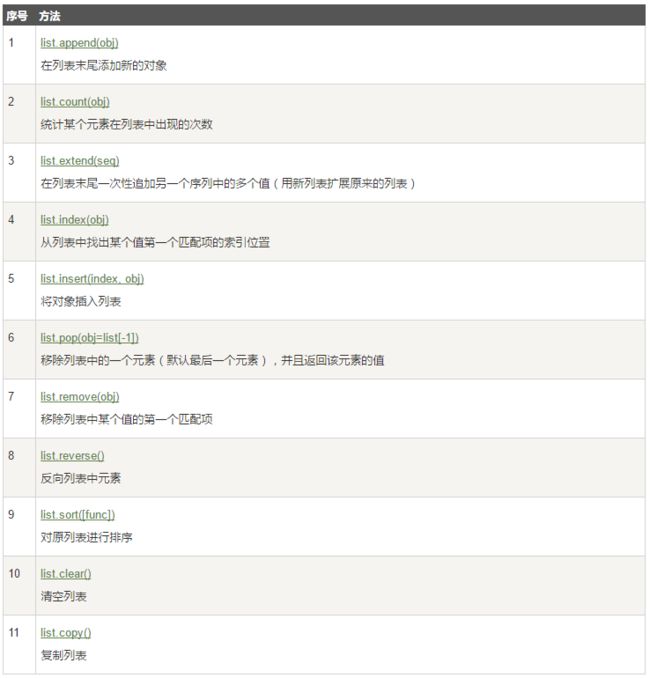Python3 基础学习笔记
Python3 基础学习笔记
这篇博客不是完整的python教程,只是我在学习python3时记下的一些容易忘记的或比较重要的知识点,里面的代码大多是转自 廖雪峰的python3教程 和 菜鸟教程 。不管怎样,还是希望本篇博客对读者有用。
基础语法
- py3里的print比py2多加了括号,使用方式为:
print ("hello world!")- 多行语句的实现方式为反斜杠 \
total = item_one + \
item_two + \
item_three- 在 [], {}, 或 ()中的多行语句,不需要使用反斜杠()
total = ['item_one', 'item_two', 'item_three',
'item_four', 'item_five']- python3中的复数用 j 表示
基本数据类型
- 输出字符串时,如果不想让其中的\变成转义字符,可以在字符串前面加一个r。
- python中的字符串不能被改变(赋值)
算术运算符
- % 返回除法的余数
- ** 返回次幂
- // 返回除法的整数
- 逻辑运算符只有 and or not
- 运算符的优先级:

编程第一步
关键字end可以用于将结果输出到同一行,或者在输出的末尾添加不同的字符,实例如下:
a, b = 0, 1
while b < 1000:
print(b, end=',')
a, b = b, a+b语句结构
- 条件语句中 elif 即c语言的 else if
- for 循环的一些用法:
languages = ["C", "C++", "Perl", "Python"]
for x in languages:
print (x)for i in range(0, 10, 3) :
print(i)数字
- 数学函数:

- 随机数函数:

- 三角函数:

字符串
- 字符串运算符:

- 字符串格式化输出:
print ("我叫 %s 今年 %d 岁!" % ('小明', 10))- python三引号允许一个字符串跨多行,字符串中可以包含换行符、制表符以及其他特殊字符。
- 字符串内建函数:





列表(list)
- 列表包含的方法:

元组(tuple)
- Python 的元组与列表类似,不同之处在于元组的元素不能修改。
- 元组的元素不能被删除,但整个元组可以被删除。
- 元组使用小括号或者不加,列表使用方括号。
- 创建空元组只要一个括号。
- 创建一个元素的元组需要在元素后面加逗号。
字典(dictionary)
- 创建字典的语法:
d = {key1 : value1, key2 : value2 }- 字典的key可以是数字,字符串或元组,但不能是列表
- 字典的value可以有列表或字典
- 字典的内置方法:

迭代器和生成器
- 迭代器用于输出列表的几种方法:
list=[1,2,3,4]
it = iter(list) # 创建迭代器对象
for x in range(len(list)):
print(next(it), end=" ")list=[1,2,3,4]
it = iter(list)
for x in it:
print (x, end=" ")import sys # 引入 sys 模块
list=[1,2,3,4]
it = iter(list) # 创建迭代器对象
while True:
try:
print (next(it), end=" ")
except StopIteration:
sys.exit()- 生成器可以理解为一种特殊的函数,在执行generator过程中,遇到yield就中断,返回该返回的数,下次又继续执行,如果没有yield可执行了,就报错。例子:
def fib(n):
a, b , counter = 0, 1, 0
while counter < n:
yield b
a, b = b, a+b
counter += 1
import sys
f = fib(20)
print(type(f))
while True:
try:
print(next(f), end=' ')
except StopIteration:
sys.exit()
for x in fib(20):
print(x, end=' ')函数
- python3 调用函数时可使用的正式参数类型:
#必须参数
def printme( str ):
print (str)
return
printme()#关键字参数
def printinfo( name, age ):
print ("名字: ", name)
print ("年龄: ", age)
return
printinfo( age = 22, name = "cyiano" )#默认参数
def printinfo( name, age = 35 ):
print ("名字: ", name)
print ("年龄: ", age)
return;
printinfo(age=50, name="cyiano")
print ("------------------------")
printinfo(name="cyiano")#不定长参数
def printinfo( arg1, *vartuple ):
print ("输出: ")
print (arg1)
for var in vartuple:
print (var)
return
printinfo( 10 )
printinfo( 70, 60, 50 )- python 函数中新加的变量为局部变量
数据结构
列表
- python中的列表可以当做堆栈来使用,每次.pop()弹出的是最后的元素
- python中的列表还可以当做队列使用,每次.popleft()弹出的是最前的元素。例如:
from collections import deque
queue = deque(["Eric", "John", "Michael"])
queue.popleft()- 列表推导式:在一行内利用for、if语句生成数组。例如:
vec = [2, 4, 6, 8]
[[x*2, x**2] for x in vec if x>2]
v1 = [2, 4, 6]
v2 = [4, 3, -9]
[x*y for x in v1 for y in v2]
[x+y for x in v1 for y in v2]- 嵌套列表,以矩阵转置为例,实现方法如下:
matrix = [
[1, 2, 3, 4], [5, 6, 7, 8], [9, 10, 11, 12]
]
transposed = [[row[i] for row in matrix] for i in range(4)]matrix = [
[1, 2, 3, 4], [5, 6, 7, 8], [9, 10, 11, 12]
]
transposed = []
for i in range(4):
transposed.append([row[i] for row in matrix])matrix = [
[1, 2, 3, 4], [5, 6, 7, 8], [9, 10, 11, 12]
]
transposed = []
for i in range(4):
transposed_row = []
for row in matrix:
transposed_row.append(row[i])
transposed.append(transposed_row)- 用del把一个列表删成空列表的方式:del a[:]
遍历
- 字典的遍历方法:
for k, v in knights.items():- 列表的遍历方法:
for i, v in enumerate(['tic', 'tac', 'toe']):- 反向遍历的方法:
for i in reversed(range(1, 10, 2)):- 按顺序遍历集合的方法:
for f in sorted(set(basket)):模块
- 一般的导入方法:
import support
support.name_access("cyiano")- 在文件夹内的导入方法:
import folder.support #文件夹最好不要有空格
folder.support.name_access("cyiano")- 给模块内函数赋予本地名称:
import folder.support
folder.support.name_access("cyiano")
access = folder.support.name_access- from…import语句的使用:
from folder.support import name_access #导入模块特定函数
from folder.support import * #导入模块所有函数
name_access("cyiano")- 使用包来管理python模块空间时,目录必须有一个 __init__.py 文件。
输入和输出
输出格式美化
- print中字符串后面可以跟上 .ljust() 或 .rjust() 或 .center() 或 zfill()
- print中用.format()的话需要在语句里加大括号{},.format()会自动扫描大括号。大括号里的内容决定输出字符的排列,例如:
import math
print('常量 PI 的值近似为 {0:5.10f}。'.format(math.pi))
# :前面数字代表format中的编号,5.10代表总长5位右对齐,保留10位小数- .format()里面可以是一个字典:
print('{name}网址: {site}'.format(name='菜鸟教程', site='www.runoob.com'))- 比较旧的传递参数方式:
import math
print('常量 PI 的值近似为:%5.10f。' % math.pi)文件对象方法
- 打开一个文件:
f = open("newtxt.txt", "r+") # "w"表示只写,"r"表示只读,"r+"表示可读又可写,还有其他模式- 读和写:
f.read(15) # 读取15个字节,没有参数则读取所有
f.readline() # 读取一行
f.readlines() # 读取所有行并返回列表,有参数则按固定长度进行分割
f.write("ahahahaaha.....") # 从指针的位置开始写(会覆盖),必须是字符串
f.seek(5) # 移动指针位置
f.close() # 最后记得关闭文件- 有一种方法可以在打开文件读取完毕后自动调用close()函数,就是使用with语句:
with open('/path/to/file', 'r') as f:
print(f.read())StringIO 和 BytesIO
- 很多时候,数据读写不一定是文件,也可以在内存中读写。StringIO顾名思义就是在内存中读写str,而BytesIO实现了在内存中读写bytes。
pickle模块
错误和异常
- try和except可以用来处理异常情况。except后面可以跟一个特定异常类型,或用元组表示的一组类型,或者什么都不跟(任何异常都会触发)。
- 如果使用else语句,必须在except后面。else语句在没有异常时执行。
- finally语句不论有无异常都会执行。
while True:
try:
x = int(input("Please enter a number: "))
except OSError as err:
print("OS error: {0}".format(err))
except ValueError:
print("Not a valid number! Try again! ")
else:
print("You just have inputed: {}".format(x))
finally:
print("next round: ")- 抛出一个异常使用raise语句,raise后面跟上特定的异常类型。
def division(x, y):
if y == 0 :
raise ZeroDivisionError('The zero is not allow')
return x / y
try:
division(2, 0)
except ZeroDivisionError as e:
print(e)
# 另一种方法
try:
division(2, 0)
except ZeroDivisionError:
raise标准库概览
- 操作系统接口:os, shutil,
- 文件通配符:glob
- 命令行参数、错误输出重定向和程序终止:sys
- 字符串正则匹配:re
- 数学:math, random
- 日期和时间:datetime
- 数据压缩:zlib
- 模块测试:doctest, unittest